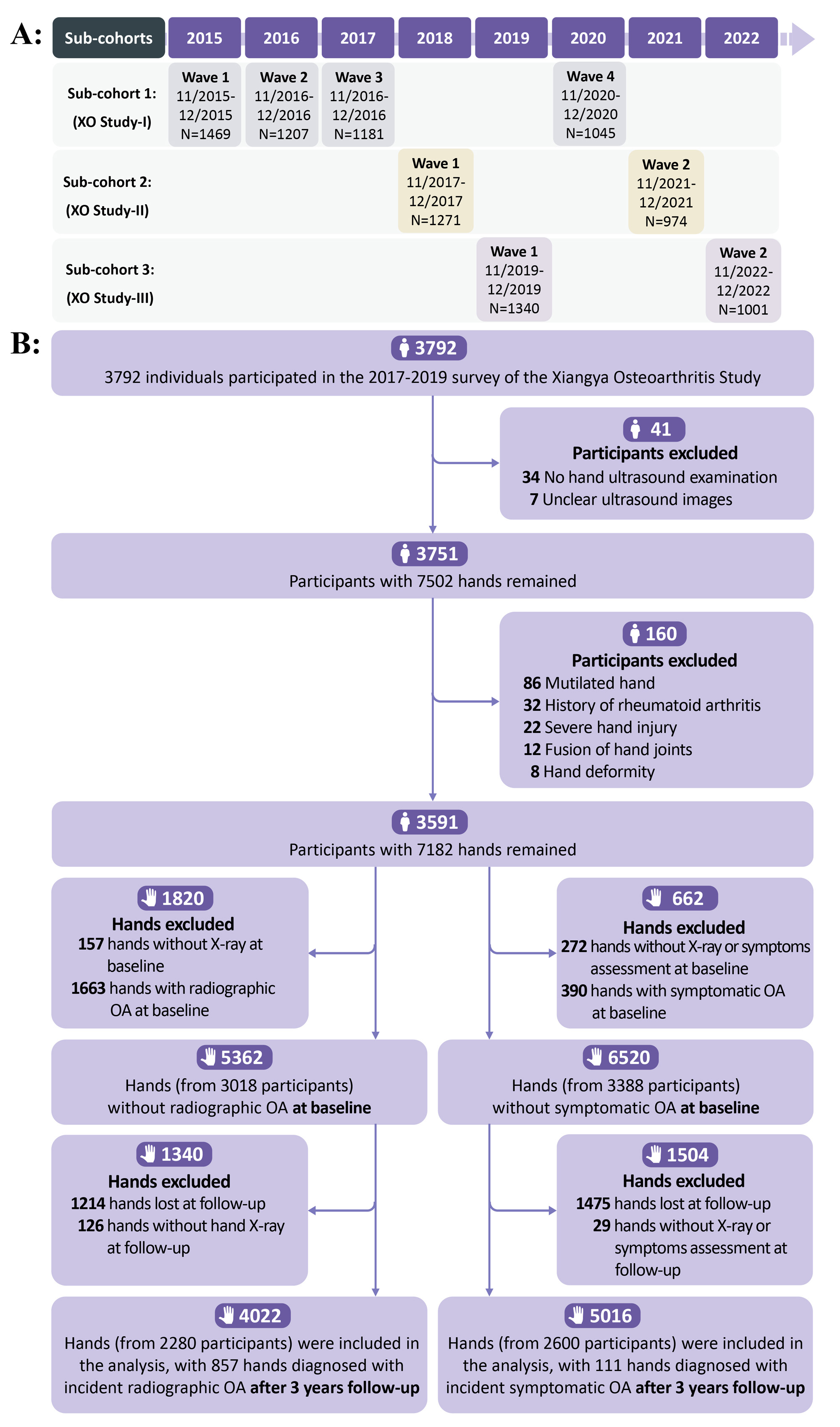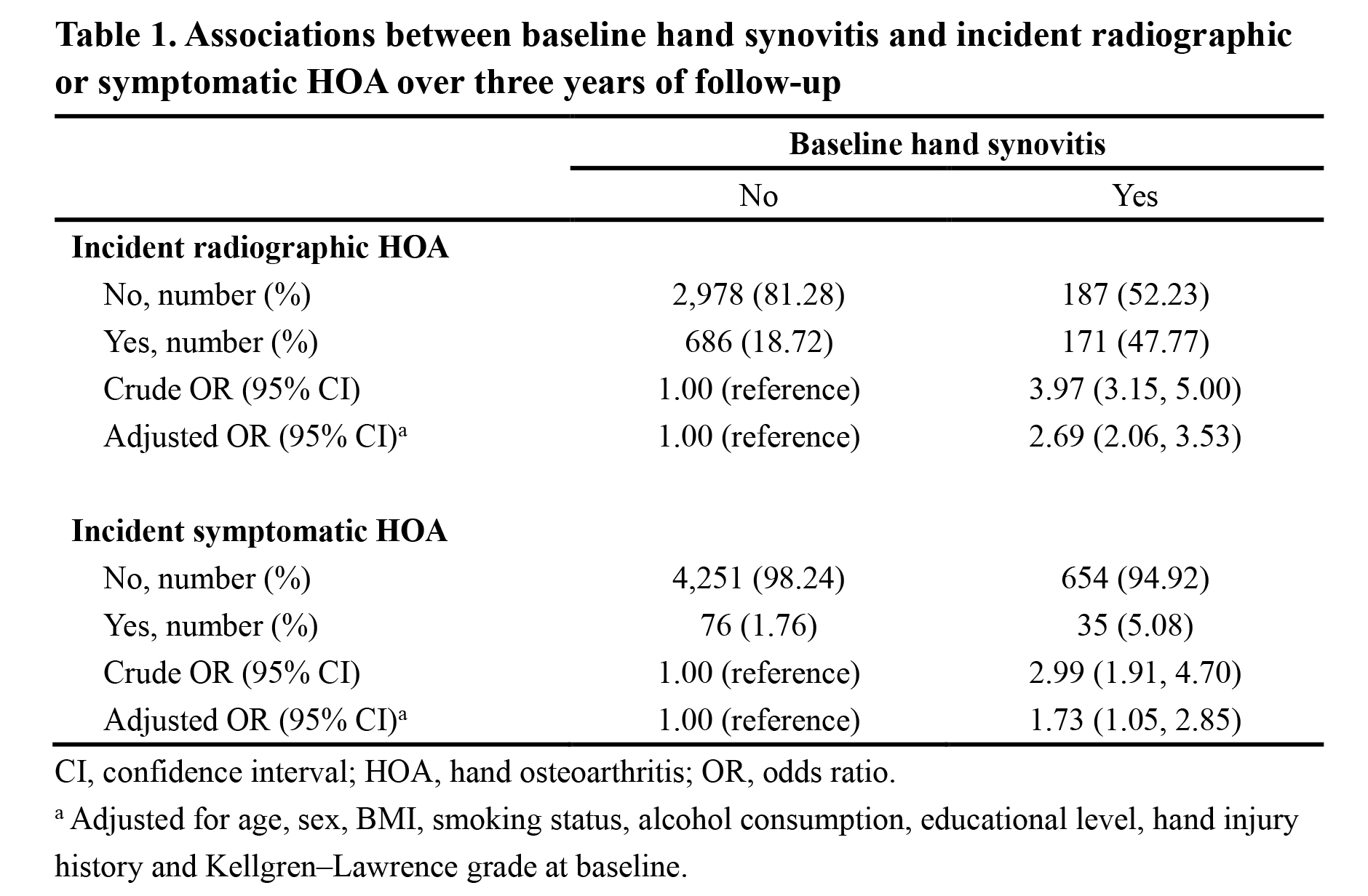Session Information
Date: Tuesday, November 14, 2023
Title: Abstracts: Osteoarthritis II: Novel Insights from Observational Studies
Session Type: Abstract Session
Session Time: 2:00PM-3:30PM
Background/Purpose: Synovitis is a modifiable pathological lesion of hand osteoarthritis (HOA). Although synovitis has been related to the prevalence and symptoms of HOA, it remains unclear whether the presence of synovitis increases the risk of incident HOA. We aimed to examine the association between baseline synovitis and incident HOA.
Methods: We conducted a prospective cohort study among participants from the Xiangya OA (XO) Study. Rdiographic and ultrasound examinations were performed on both hands and reliability has been described in previous studies. Hands without baseline radiographic HOA (Kellgren-Lawrence grade >2 in any joint of a hand) or symptomatic HOA (Kellgren-Lawrence grade >2 plus self‐reported symptoms in the same joint of a hand) were included in the analyses. Incident HOA was defined as the development of radiographic HOA or symptomatic HOA during the three-year follow-up. Hand synovitis was defined as grey-scale synovitis >2 grade by ultrasound. The inflammatory activity of the synovitis was assessed by the Power Doppler signal (PDS) detected in the synovium. We used generalized estimating equations to examine the relation of synovitis to the risk of incident radiographic and symptomatic HOA, respectively. We assessed the dose-response relationship between the synovitis load (number of hand joints affected by synovitis) and synovitis inflammatory activity (i.e., no synovitis, synovitis without PDS, and synovitis with PDS) at baseline and the risk of HOA. We quantified the impact of synovitis on incident HOA risk by population attributable fractions (PAF).
Results: Included in the analysis were 4,022 hands (2,280 participants) for incident radiographic HOA and 5,016 hands (2,600 participants) for incident symptomatic HOA, respectively (Figure 1). During three years of follow-up, 857 (21.3%) hands developed incident radiographic HOA and 111 (2.2%) hands developed symptomatic HOA. As shown in Table 1, baseline hand synovitis was associated with an increased risk of radiographic HOA (OR=2.69, 95% CI: 2.06-3.53, P <0.01) and symptomatic HOA (OR=1.73, 95% CI: 1.05-2.85, P=0.03). Figure 2 shows there was a strong dose-response relationship between the number of hand joints with synovitis and the risk of radiographic and symptomatic HOA (P for trend <0.05). Compared with hands without synovitis, the risk of radiographic HOA was 2.6-fold higher among hands with synovitis but without PDS (OR=2.56, 95% CI: 1.95-3.36, P <0.01), and 10.4-fold higher among hands with both synovitis and PDS (OR=10.42, 95% CI: 1.51-71.81, P=0.03), with the P for trend being statistically significant. We could not assess the relationship between baseline synovitis activity and the risk of symptomatic HOA because of the limited sample size. Approximately 12.5% of incident radiographic HOA and 13.3% of incident symptomatic HOA were attributed to hand synovitis.
Conclusion: Synovitis is associated with an increased risk of both incident radiographic and symptomatic HOA in the general population. The strength of the associations increases with the load and inflammatory activity of synovitis. These results support synovitis as a risk factor for HOA and a prospective target for disease prevention.
To cite this abstract in AMA style:
Jiang t, Weng Q, Li J, Zhang Y, Zhang W, Doherty M, Yang T, Yang Z, Liu K, Chen Q, Wei J, Lei G, Zeng C. Synovitis and the Risk of Incident Hand Osteoarthritis: Data from the Xiangya Osteoarthritis Study [abstract]. Arthritis Rheumatol. 2023; 75 (suppl 9). https://acrabstracts.org/abstract/synovitis-and-the-risk-of-incident-hand-osteoarthritis-data-from-the-xiangya-osteoarthritis-study/. Accessed .« Back to ACR Convergence 2023
ACR Meeting Abstracts - https://acrabstracts.org/abstract/synovitis-and-the-risk-of-incident-hand-osteoarthritis-data-from-the-xiangya-osteoarthritis-study/



